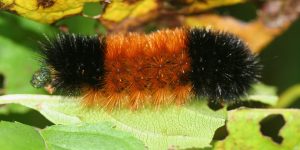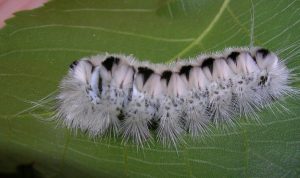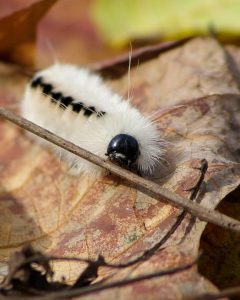You may have seen this post somewhere on social media:
“POISONOUS CATERPILLAR FOUND IN OHIO— It may look like a woolly worm..but it’s not. This is a venomous caterpillar from Canada known as the White Hickory Tussock Moth Caterpillar and it’s been spotted in northeast Ohio. It can be either white or brightly colored. More importantly, it has hairs with barbs that can stick into your skin and its back contains rash-giving venom. Don’t touch it!”
As naturalists, we are constantly dispelling myths and calming fears about our native wildlife, but we are typically fielding questions about the usual suspects: snakes, spiders, bats, coyotes. The “caterpillar terror” has only surfaced in the last few years and is a bit mystifying to us. As far as I can tell, this all started with another post that described the effects of a little girl’s decision to lick one of these caterpillars. Her mother thought it would be helpful to warn people that this was a bad idea. Unfortunately, much of her information was simply wrong and has spread across social media without correction. I will attempt to set the facts straight about this caterpillar.
What is a caterpillar?
First of all, caterpillars are insects. They have six true legs and several pairs of prolegs that grasp branches and prevent them from falling off. They go through metamorphosis, changing first into a pupa (sometimes inside a cocoon, sometimes not), and then turning into a butterfly or moth. They are essential to the diet of most of Ohio’s songbirds. One nesting family of chickadees will eat thousands of caterpillars in one summer. They may seem insignificant, but they keep our ecosystems running.

One group of caterpillars is the tiger moth family. These caterpillars are often furry and brightly colored to warn predators that they are unpleasant to eat. This family includes the lovable banded woolly bear, or woolly worm, with its alternating orange and black bands. It also includes the “dreaded” hickory tussock moth caterpillar, which is the inspiration for this post.

Hickory tussock moth caterpillars, Lophocampa caryae, are found in Canada. They are also found throughout the eastern United States, from Maine and Minnesota down to Georgia and Texas. There is nothing new about them. These caterpillars are a native species and have been part of our landscape since before the first humans arrived in this area. To suggest that they are some sort of invader is just fear-mongering. Furthermore, they are always white with black markings, never brightly colored. If you see a furry caterpillar that is not white and black, it is a completely different species.
A female hickory tussock moth will lay hundreds of eggs at a time. The caterpillars eat many different types of leaves, but I usually see them on walnut or hickory trees. After eating and growing for several weeks, the caterpillars will drop off their host plant and go wandering. This is when most people encounter them, especially in September and October. They are hunting for a perfect spot to make a cocoon and spend the winter in hibernation.
Are caterpillars really dangerous?

Caterpillars have one goal in life: avoid being eaten. There are many strategies for survival, but hickory tussock moths rely on their fur to protect them. These hairs can cause irritation and swelling if they touch sensitive areas like mucous membranes around the eyes or mouth. That way, if a bird bites down on a hickory tussock moth caterpillar, the hairs become embedded in the bird’s mouth and it will feel pain and swelling almost immediately. If the caterpillar is lucky, it will be spit out without injury. In addition, the contrasting white and black fur makes these caterpillars conspicuous so many animals learn to avoid them.
Now, these caterpillars have no venom or poison. I will use the word sting to describe the effects of the caterpillar’s hairs, but the process is nothing like a bee or scorpion’s sting, where venom is injected and spreads throughout the body. The hairs usually only cause a reaction in the spot where they touch the skin. They are also unlikely to sting you at all unless they feel threatened. I often see children playing gently with these caterpillars with no ill effects. Sometimes people who develop severe rashes have ended up with the caterpillar in their shirt or pants, where constant friction forces the caterpillar to defend itself. Other times people are startled by a caterpillar on them and swat at it, receiving a sting in the process.
Some people are hypersensitive to caterpillar hair just like some people have allergies to cats or dogs. This can result in a rash that spreads to other parts of the body. If you have a history of allergic reactions to any insect, including bee or wasp stings, avoid touching hickory tussock moth caterpillars. In fact, and this goes for everyone, avoid touching any furry or spiky caterpillar you are unfamiliar with, since some of our native species do actually possess venom and can give a much more painful sting. The saddleback caterpillar and the io moth caterpillar are two common examples.
Nearly everything in that previously mentioned social media post is false, except the last part—don’t touch it. This is sound advice about any wild animal. I always tell people “if you leave it alone, it will leave you alone,” but I might have to start adding “and definitely don’t lick it!”
(By Craig Biegler, Naturalist at Highbanks Metro Park)
